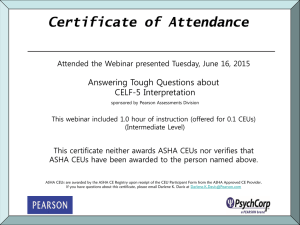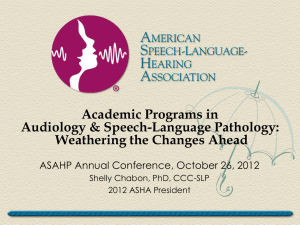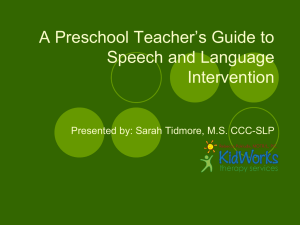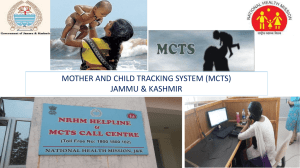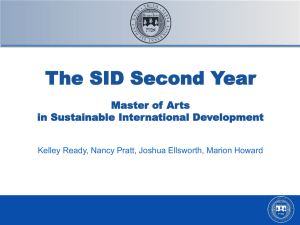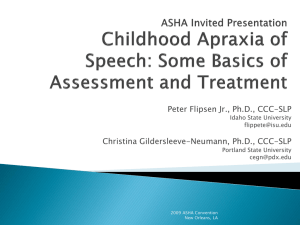Block Schedule - Sal..
advertisement
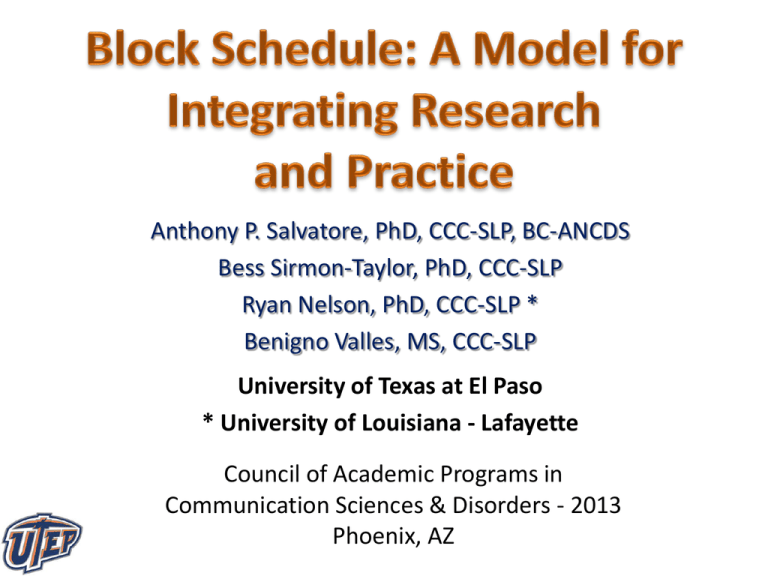
Anthony P. Salvatore, PhD, CCC-SLP, BC-ANCDS Bess Sirmon-Taylor, PhD, CCC-SLP Ryan Nelson, PhD, CCC-SLP * Benigno Valles, MS, CCC-SLP University of Texas at El Paso * University of Louisiana - Lafayette Council of Academic Programs in Communication Sciences & Disorders - 2013 Phoenix, AZ Anthony P Salvatore has no financial or nonfinancial relationships to disclose. Bess Sirmon-Taylor has no financial or nonfinancial relationships to disclose. Ryan Nelson has no financial or nonfinancial relationships to disclose. Benigno Valles has no financial or nonfinancial relationships to disclose. Learning outcomes By the end of the session, participants will be able to: • Describe the 2-5-1-5-2 Block Schedule Curriculum model. • Describe the assessment of student satisfaction. • Describe an approach to facilitating implementation of this model to upper administration. Introduction • Integrating research and clinical practice is difficult for speech language pathology academic programs (Apel, 2006; Salvatore & Hardee, 1996). • This presentation will describe an innovative block schedule model based upon the hypothesis that parsing academic and clinical experiences will facilitate utilization of research and evidence based practice. Problem: How do we integrate clinical practice and research principles? ASHA calls for integration: a.Curriculum Informational Packet b.Developed Quality Indicators for the integration of clinical practice and research principles. Efforts to Promote EBP • Infusion of Evidence-Based Practice • Why? – Accountability – Professional responsibility – Ethics Evidence from the literature: From a recent issue of the ASHA Leader (Johnson, 2013): • Integrating classroom and clinic, requiring acquisition of information and case-based, critical thinking application into clinical practice. • Development of competencies through multiple exposures across the curriculum. Evidence from the literature: • “…curriculum and teaching should be relevant to market requirements in order to avoid a mismatch of skills.” Daud, et al, 2010 • Integration of academic work plus research- based application yields an effective accomplishment of learning objectives. Carpenter and Pappenfus, 2009 Integration of Clinical Practice & Research: Successful Curriculum Models ASHA Informational Packet Oppenheimer, B., Self, T. & Sieff, S. (2005), from the ASHA Doctoral Shortage Focused Initiative • How? – EBP Analysis Worksheet – EBP Clinical Decision Making Flowchart Evidence-Based Practice and Practice-Based Evidence • Application of research methods to clinical practice • Learn to use clinical procedures that are based upon research information and not activities based. • Develop a common language to describe clinical diagnostic and treatment procedures Quality Indicators for Integrating Research and Clinical Practice in Communication Sciences and Disorders (CSD) Programs: Academic Program Self-Assessment • Originally developed in 2006. • Quality Indicators (QIs) were designed to assist Communication Sciences and Disorders programs in assessing how well clinical practice and research are integrated. • Promote integration of clinical practice and research. • Facilitate discussion between academic and clinical faculty. • Collect and disseminate information on successful integration models and resources. • Assist in implementing changes. Quality Indicators • Self-rating program strengths and needs for each quality indicator. Sample questions are provided. • The QIs are grouped in five sections: Curriculum and Department Goals Coursework Faculty Students Clinical Practica UTEP Self-Assessment of QI - January 2012 • General Curriculum Considerations: • QI reflect a possible progression for programs to incorporate clinical practice and research into their department goals and curriculum. • 5 point scale: 1 = Strongly Disagree to 5 = Strongly Agree • 8 QI: Scored 5 (Strongly Agree) on all 8 QI • The academic and clinical curricula reflect adequate depth of study of clinical research methods and their application to clinical practice. Course Work QI • 5 QI: Scored 5 (Strongly Agree) on all 5 QI. • Course outlines reflect an application and integration of clinical research to clinical practice through readings and class assignments. • Academic and clinical faculty will use formative and summative assessments to determine student learning as related to EBP concepts presented in the respective courses and/or practica. Faculty Preparation QI • 13 QI: Scored 5 (Strongly Agree) on 10/13. Scored 4 (Agree) on 3/13. • Academic and clinical faculty develop and/or participate in at least one joint research project during a 2-year period. • Academic and clinical faculty include at least one student in a joint research project during a 2-year period. • Academic and Clinical faculty attend EBP continuing education courses/workshops during a 2-year period. Students QI • 6 QI: Scored 5 (Strongly Agree) on 5/6 QI Scored 4 (Agree) on 1/6 QI • Students participate in at least one research project with a faculty member during their graduate course work. • Students’ research projects are presented and/or published at local, state, national venues. Clinical Practicum QI • 6 QI Scored 5 (Strongly Agree) 6/6 • Clinical practicum experiences require students to find, appraise, and apply relevant clinical research in the process of treating and evaluating their clients. • Assessment and treatment plans contain references to research, and the quality of the available research, as part of the rationale. UTEP’s Integration of Research and Practice: • All graduate courses have students review research articles. • All graduate courses have students use evidence to support use of diagnostic and treatment procedures. • Research courses and Capstone Paper: – 1st Semester – Comparison of group and single subject designs – 3rd Semester – Summer-Efficacy Course …review of evidence across a number of disorders UTEP Curriculum Classroom Parameters: • EBP…journal critiques, specified questions • Research Course…compare & contrast group and Single Subject Design • ICF… application of this model, according to ASHA Scopes of Practice for Speech Language Pathology and Audiology Clinical Parameters: • Research Competencies • Implement SSD • Implement EBP…data, expertise, family Means of Assessment Based upon Bloom’s Revised Cognitive Taxonomy • Remembering (R)-recall of facts and specific info; • Applying (A) – use of info in a new situation, ability to use knowledge in a new situation; • Analyzing (An) – ability to break down material into component parts and identify the relationships product Means of Assessment Based upon Bloom’s Revised Cognitive Taxonomy • Evaluating (E) – judgments about value based on internal and external criteria, extent to which materials and objects meet criteria; • Creating(C) –synthesizing from diverse sources of information, creating an organizational structure from that information Means of Assessment • Identify, describe and interpret the various group and single-subject research designs • (R, C, A, An, E) • Identify, describe, use and interpret various parametric and nonparametric statistical tests • (R, A, E) • Demonstrate the ability to design, plan, implement and describe in oral and written form a treatment or group study plan for a patient using a single-subject (SLP students must do a single subject design) or group design • (R, A, An, E, C) Means of Assessment • Demonstrate the ability to produce competently written and oral critiques of assigned journal articles • (A, An, E, C) • Identify, describe and interpret the possible multicultural/multilingual variables that may influence research in the health sciences • (C, A) • Identify, describe and interpret the ethical issues involved in carrying out traditional and applied research in the health sciences • (A, An, E, C) Journal Critique Questions 1) Was the rationale for the treatment procedure clearly stated and was it relevant? 2) What were the independent and dependent variables? 3) Was the procedure described so you could replicate the study? 4) Did the authors use parametric or nonparametric statistical tests to analyze their data? 5) Was/Were the conclusion(s) justified by the reported data? 6) Did the review of the literature cite counter cases? 7) Was the experimental question operationally defined? Single Subject Designs Single-Subject Clinical Research Capstone Project: • Design and describe a treatment study to satisfy capstone requirement. • Students must use a single subject design that will permit an assessment of the efficacy of treatment procedure. • Students design a study based upon a patient or individuals presently in treatment or improve upon a published treatment study. • Students include an abstract, a current and extensive review of the literature, treatment hypothesis, procedures, results (either real or hypothetical), and discussion. CAA Accreditation Standards and UTEP Knowledge & Clinical Competencies • ASHA Standard III-Ethics • UTEP Competence-Implementation 14 • ASHA Standard III-F Research Principles • UTEP Competencies-Planning 1b, 7, 9a&b • ASHA Standard IV-B-Oral & Written Skills • UTEP Competencies-Implementation-Record Keeping 1,2,5; Diagnostic 8a • ASHA Standard IV-G-2.d Outcome Measures • UTEP Competencies-Planning 9b, Record Keeping 4 UTEP Extended The Integration Effort to Promote EBP/Research • We looked at a model that would facilitate the use of EBP. • Feedback from students was that they tended not to use EBP once they graduated; no support for its implementation. • Short intervals of classroom and practicum experiences Traditional Semester Schedules • Combination of clinical practicum and classroom. • One year to complete all classroom courses and second year off-campus practicum. • UTEP offers a third model. • Rationale: Short concentrated effort Integration of research principles in clinical training, with particular attention on SSD Student able to focus Student driven to integrate in the clinic and classroom The working hypothesis for this model is that block scheduling of spaced learning experiences will provide students with the opportunity to consolidate their learning as they proceed through the educational program. We have labeled the model the “2-5-1-5-2 Block Schedule”. Procedure During the initial two (2) weeks of the semester, the students are exposed to intense classroom experiences that combine content and casebased learning. This combination prepares the students for their clinical educational experience. For the next five (5) weeks of the semester, the students are engaged in a clinical practicum experience for 25 hours a week. During the clinical experience, students are given class assignments that utilize on-line interactions. Next, the students return for one (1) week of classroom experience at mid-semester. During this week the students are given a mid-term evaluation. Then the students return to their practicum site for five (5) weeks, culminating in a return to the classroom for the final two (2) weeks of the semester. Again, the students experience a combination of content and case-based learning activities. Final class projects are completed during this two week time frame, and examinations are given according to the regular academic schedule. Summative and Formative Clinical Assessment • Across their entire clinical education, students are evaluated using an extensive competence based, multidimensional rating system of performance and clinical independence assessment, based on the Wisconsin Procedure for Appraisal of Clinical Competence (Shriberg, et.al., 1975). Obstacles • Students reported feeling inadequately prepared for therapy in all clinical areas (e.g., working with a fluency client prior to taking the fluency class). – This happens in every program • Intense and truncated classroom experience – Weekly assignments on Blackboard Satisfaction Survey Scale For initial assessment of this model, we chose to have the students complete a satisfaction survey. The survey used a four point scale to respond to twelve questions, plus an opportunity to comment. 1 Strongly Agree 2 Agree 3 Disagree 4 Strongly Disagree 1. I am happy with my experience with this new schedule. 2. Scheduling my reading and study time is much easier on this schedule. 3. The integration of theoretical information into clinical practice has been successful. 4. The integration of research principles into practice has been successful. 5. The concentrated clinical practicum experience makes my reading assignments meaningful to me. 6. I am successful in preparing for classes because of my more intensive clinical practice experience. 12. I am encouraged about the future of this new schedule. • The data from 8 different cohorts is reported. • Cohorts were comprised of 1st and 2nd year graduate students who were assessed during either the Fall, Spring or Summer semesters of their first and second year of the graduate program. Table 1. Percentage of satisfaction ratings for questions 16,12. Combining Strongly Agree & Agree ratings per cohort Strongly Agree/Agree Cohort #1 Cohort #2 Fall 90 Spring 78 Fall 81 Spring 71 Summer 87 Fall 77 Spring 86 Cohort #3 Cohort #4 Cohort #5 Fall 96 Spring 98 Spring 91 Spring 97 Spring 97 Spring 90 Spring 97 Cohort #6 Summer 83 Cohort #7 Spring 83 Spring ?? Spring 98 Cohort #8 • The preceding data shows that the model is acceptable and reasonable across eight different cohorts of SLP graduate students. • Students were also given the opportunity to provide open-ended written comments regarding their perceptions and experiences with the Block Schedule as part of the survey. Student Comments: • “…it requires tremendous structure and discipline in order to stay on task.” • “I personally find this new schedule to be challenging but have made every attempt to make it work. It has been helpful and beneficial in applying what we learn in class in our clinical setting. Overall, I am pleased with the schedule.” • “It really allows time to put into practice many of the theoretical concepts read about and studied in class, without having to worry about a quiz or test all the time.” • “I have been extremely satisfied with the block schedule.” • “The block schedule really is amazing because it provides breathing room.” • “the block schedule is very practical. It gives me time to organize.” • “Block scheduling is unique to UTEP. Let’s keep it that way to help us stand out.” Graduate Students’ Rating of the Questions, across all cohorts 1. I am happy with my experience with the block schedule. 95% 2. Scheduling my reading and study time is much easier on this schedule. 90% 3. The integration of theoretical information into clinical practice has been successful. 92% 4. The integration of research principles into practice has been successful. 90% 5. The concentrated clinical practicum experience makes my reading assignments meaningful to me. 91% 6. I am successful in preparing for classes because of my more intensive clinical practice experience. 89% 12. I am encouraged about the future of this schedule. 94% Faculty Satisfaction Survey • The faculty measurement instrument is evolving, but preliminary drafts involve questions dealing such as these: – Rating of overall experiences with the schedule – Evolution of the quality of questions asked by the students across all semesters – Rating of academic scholarship productivity Other satisfaction surveys in development: • External clinical supervisors • Consumers of on-campus clinical services • Long-term follow-up with alumni five years post-graduation determine their assessment of the impact of the block schedule on their clinical careers How to approach administration with this suggestion: • The evidence – Benefit to students (Our data) – Benefit to faculty – tenure track faculty have large blocks of time to collect data, write, et cetera – No additional cost factors involved How to approach students with the new model: • Orientation – Non-traditional schedule – Intense practicum experience • Allows increased flexibility for practicum placements – Able to travel to out-of-town sites How to approach external stakeholders : • Have to get the external clinical supervisors on board – Non-traditional schedule – Intense practicum experience How to approach our consumers: • There will be a break in services between semesters and at mid-semester. Conclusions • Students are satisfied with the novel 2-5-1-5-2 block schedule. • Students appear to be integrating classroom and clinical information. • Faculty must support such efforts or the students will not succeed. • Faculty feel they are being more productive with the larger blocks of time available to work on scholarly activities. Directions for Further Research • Survey the satisfaction of external practicum supervisors, consumers, faculty, and alumni. • Continue the development of a mechanism for measuring faculty productivity within the context of the Block Schedule. Bibliography Apel, K. (2006, April 11). Integrating clinical and research viewpoints into graduate education. The ASHA Leader, 11(5), 8-9. ASHA (n.d.). International Classification of Functioning, Disability, and Health (ICF). http://www.asha.org/slp/icf/ ASHA (2007). Quality Indicators for Integration of Clinical Practice and Research: Program Self-Assessment Pilot Program. http://www.asha.org/members/phdfaculty-research/teach- tools/ QIAssess. Carpenter, NE & Pappenfus, TM. (2009). Teaching research: a curriculum model that works. Journal of Chemical Education, 86 (8). http://www.jce.divched.org/Journal/Issues/2009/Aug/abs940.html Daud, S, Abidin, N, Sapuan, NM, Rajadurai, J. (2010). Creating sustainable and competitive employees through the design of innovative higher education curriculum. Communications of the IBIMA, Vol. 2010, Article ID 486866. Bibliography Johnson, A. (2013, February 01). Academic Edge: Realizing Our Educational Future— Now : Graduate programs need to realign curricula with a fast-shifting health care environment. The ASHA Leader. Oppenheimer, B., Self, T., & Sieff, SL. (2005). Integration of clinical practice and research: Successful curriculum models. ASHA Web-enhanced Telephone Seminar. ASHA: Rockville, MD. Salvatore, AP & Hardee, WP. (1996, April). Preparing students for field practice: One solution. ASHA Special Interest Division 11: Administration and Supervision newsletter, 6(1), 7-9. Shriberg, LB, Filley, FS, Hayes, DM, Kwiatkowski, J, Schatz, JA, Simmons, KM, Smith, ME. (1975, March). The Wisconsin procedure for appraisal of clinical competence (WPACC): Model and data. ASHA, 17(3), 158-165. Anthony P. Salvatore, PhD, CCC-SLP, BC-ANCDS asalvatore@utep.edu
